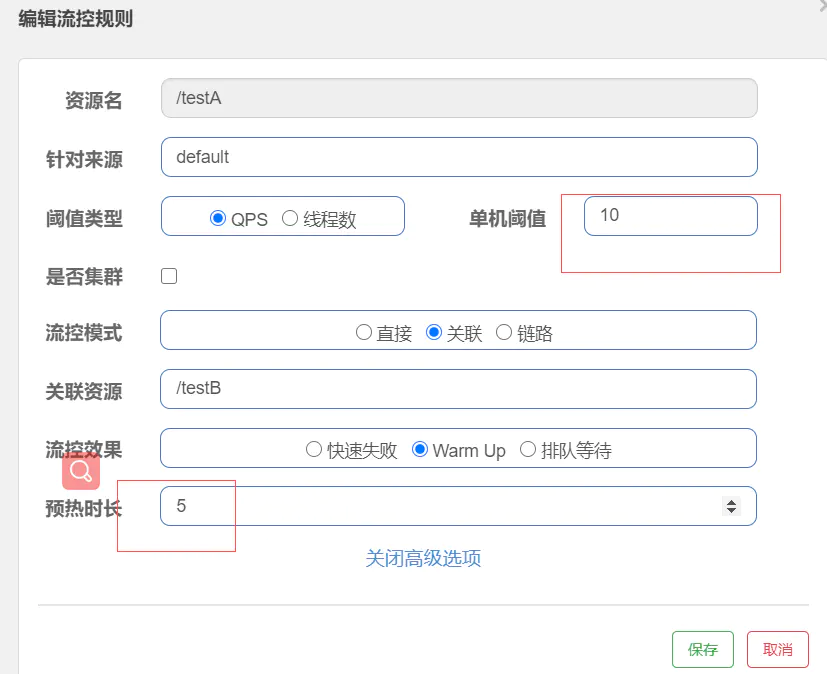Sentinel-FlowSlot
FlowSlot流控规则

这里面主要是根据qps或者线程数配置,来做限流。
private static boolean passLocalCheck(FlowRule rule, Context context, DefaultNode node, int acquireCount, boolean prioritized) { // 根据配置获取关联的node Node selectedNode = selectNodeByRequesterAndStrategy(rule, context, node); if (selectedNode == null) { return true; } return rule.getRater().canPass(selectedNode, acquireCount, prioritized); }
限流规则的实现有这么几个

都实现了TrafficShapingController接口
DefaultController快速失败
这个策略就是说当发现如果加上请求数使得当前的QPS超过阈值的时候,则快速失败。不过有个前提在node的优先级高且当前是检验QPS的时候,如果计算得到的等待时间不超过500ms,则当前的qps计算在未来的样本窗内,并sleep相应的等待时间,依然放行。
public boolean canPass(Node node, int acquireCount, boolean prioritized) { int curCount = avgUsedTokens(node); if (curCount + acquireCount > count) { // 被流控 // 如果流控策略是基于QPS 并且优先级较高 if (prioritized && grade == RuleConstant.FLOW_GRADE_QPS) { long currentTime; long waitInMs; currentTime = TimeUtil.currentTimeMillis(); /** * 计算要等待的时间 */ waitInMs = node.tryOccupyNext(currentTime, acquireCount, count); if (waitInMs < OccupyTimeoutProperty.getOccupyTimeout()) { // 添加占用未来时间对应的样本窗的pass配额 node.addWaitingRequest(currentTime + waitInMs, acquireCount); // 统计 OccupiedPass node.addOccupiedPass(acquireCount); sleep(waitInMs); // PriorityWaitException indicates that the request will pass after waiting for {@link @waitInMs}. throw new PriorityWaitException(waitInMs); } } return false; } return true; }
那么等待时间是如何计算的呢?
@Override public long tryOccupyNext(long currentTime, int acquireCount, double threshold) { double maxCount = threshold * IntervalProperty.INTERVAL / 1000; // 0 long currentBorrow = rollingCounterInSecond.waiting(); if (currentBorrow >= maxCount) { return OccupyTimeoutProperty.getOccupyTimeout(); } // 500 int windowLength = IntervalProperty.INTERVAL / SampleCountProperty.SAMPLE_COUNT; /** * 这个算法 是获取当前时间对应的样本窗的结束时间 往前推一个单位时间窗 来获取到一个能统计到当前时间对应的样本窗的最早时间 */ long earliestTime = currentTime - currentTime % windowLength + windowLength - IntervalProperty.INTERVAL; int idx = 0; /* * Note: here {@code currentPass} may be less than it really is NOW, because time difference * since call rollingCounterInSecond.pass(). So in high concurrency, the following code may * lead more tokens be borrowed. */ // 当前时间单位窗口的统计数 long currentPass = rollingCounterInSecond.pass(); /** * 这块逻辑很好理解: * 从最早时间 到 当前时间为止 * 初始等待时间为 当前时间对应的样本窗,剩余的时间长度 * 如果去掉最早样本窗的pass数之后,发现仍然大于阈值 ,则等待时间数 + 样本时间窗长度 * 直到等待时间超过500ms 也就是说最大的等待时间不超过500ms */ while (earliestTime < currentTime) { long waitInMs = idx * windowLength + windowLength - currentTime % windowLength; if (waitInMs >= OccupyTimeoutProperty.getOccupyTimeout()) { break; } long windowPass = rollingCounterInSecond.getWindowPass(earliestTime); if (currentPass + currentBorrow + acquireCount - windowPass <= maxCount) { return waitInMs; } earliestTime += windowLength; currentPass -= windowPass; idx++; } return OccupyTimeoutProperty.getOccupyTimeout(); }
RateLimiterController排队等待
这里边利用的漏斗算法实现,假设阈值5qps,那么允许1秒内通过5个请求,这样如果需要处理2个请求,消耗的时间为 2/5*1000ms
上次通过的时间+消耗的时间 = 如果pass,则需要当前时间达到的这个期望时间。
接下来对期望时间和当前时间比较,如果当前时间大,说明早就可以通过了,并重置通过时间
如果期望时间大,那么就算一下离期望时间还有多少时间,这个多少时间就是等待时间。
如果这个等待时间超过了配置的500ms,则不通过,如果不超过500ms,则sleep等待时间,并最后pass
@Override public boolean canPass(Node node, int acquireCount, boolean prioritized) { // Pass when acquire count is less or equal than 0. if (acquireCount <= 0) { return true; } // Reject when count is less or equal than 0. // Otherwise,the costTime will be max of long and waitTime will overflow in some cases. if (count <= 0) { return false; } long currentTime = TimeUtil.currentTimeMillis(); // Calculate the interval between every two requests. // 计算acquireCount通过需要耗时 long costTime = Math.round(1.0 * (acquireCount) / count * 1000); // Expected pass time of this request. // 计算期望的pass时间点 long expectedTime = costTime + latestPassedTime.get(); if (expectedTime <= currentTime) { // 当前时间超过了通过点 pass // Contention may exist here, but it's okay. latestPassedTime.set(currentTime); return true; } else { // 没有到达pass通过的时间点 // Calculate the time to wait. long waitTime = costTime + latestPassedTime.get() - TimeUtil.currentTimeMillis(); if (waitTime > maxQueueingTimeMs) { //等待时间超过了配置的maxQueueingTimeMs return false; } else { long oldTime = latestPassedTime.addAndGet(costTime); try { // 二次判断 waitTime = oldTime - TimeUtil.currentTimeMillis(); if (waitTime > maxQueueingTimeMs) { latestPassedTime.addAndGet(-costTime); return false; } // in race condition waitTime may <= 0 // 等待,后续在处理 if (waitTime > 0) { Thread.sleep(waitTime); } return true; } catch (InterruptedException e) { } } } return false; }
WarmUpController预热流控
在初始化的时候,warmUp斜率模板已经订好了coldFactor warningToken maxToken slope 这些属性也就定义好了这个warmup的整个过程。
public class WarmUpController implements TrafficShapingController { // FlowRule中设定的阈值 protected double count; /** * coldFactor:冷却因子,默认为3,表示倍数,即系统最"冷"时(令牌桶饱和时),令牌生成时间间隔是正常情况下的多少倍 */ private int coldFactor; // warningToken:预警值,表示进入预热或预热完毕 protected int warningToken = 0; /** * maxToken:最大可用token值,计算公式:warningToken+(2*时间*阈值)/(1+因子),默认情况下为warningToken的2倍 */ private int maxToken; /** * slope:斜度,(coldFactor-1)/count/(maxToken-warningToken),用于计算token生成的时间间隔, * 进而计算当前token生成速度,最终比较token生成速度与消费速度,决定是否限流 */ protected double slope; /** * 令牌桶中令牌的数量 */ protected AtomicLong storedTokens = new AtomicLong(0); // 最后一次添加令牌的时间戳 protected AtomicLong lastFilledTime = new AtomicLong(0); public WarmUpController(double count, int warmUpPeriodInSec, int coldFactor) { construct(count, warmUpPeriodInSec, coldFactor); } public WarmUpController(double count, int warmUpPeriodInSec) { construct(count, warmUpPeriodInSec, 3); } private void construct(double count, int warmUpPeriodInSec, int coldFactor) { /** * 假设配置的阈值是QPS=5 一秒内的允许通过5个 count=5 预热时间为10s 即warmUpPeriodInSec =10 * 则 coldInterval = coldFactor * stableInterval = 3 * 0.2s = 0.6s * warmUpPeriodInSec = 梯形面积 = 0.5 * (coldInterval+stableInterval)*(maxToken - warningToken) 而 maxToken = 2 * warningToken * 计算得到 10 = 0.4 * 1 * warningToken warningToken = 25 maxToken =50 * */ if (coldFactor <= 1) { throw new IllegalArgumentException("Cold factor should be larger than 1"); } this.count = count; this.coldFactor = coldFactor; // thresholdPermits = 0.5 * warmupPeriod / stableInterval. // warningToken = 100; warningToken = (int)(warmUpPeriodInSec * count) / (coldFactor - 1); // / maxPermits = thresholdPermits + 2 * warmupPeriod / // (stableInterval + coldInterval) // maxToken = 200 maxToken = warningToken + (int)(2 * warmUpPeriodInSec * count / (1.0 + coldFactor)); // slope // slope = (coldIntervalMicros - stableIntervalMicros) / (maxPermits // - thresholdPermits); slope = (coldFactor - 1.0) / count / (maxToken - warningToken); }
这个参考guava的RateLimiter的实现,不过相对guava的预热机制比较简单。sentinel将前一个样本窗口的qps用来初始化定义的warmUp斜率模板,计算得出当前的token数,根据这个token数,再来计算得出一个生成token数速率,
当前的qps为消耗速度,如果消耗比生成快,那么就流控,如果消耗速率慢,那么直接比较qps是否达到阈值。
@Override public boolean canPass(Node node, int acquireCount, boolean prioritized) { // 获取当前1s的QPS long passQps = (long) node.passQps(); // 获取上一窗口通过的qps long previousQps = (long) node.previousPassQps(); // 生成和滑落token syncToken(previousQps); // 开始计算它的斜率 // 如果进入了警戒线,开始调整他的qps long restToken = storedTokens.get(); if (restToken >= warningToken) { // 如果令牌桶中的token数量大于警戒值,说明还未预热结束,需要判断token的生成速度和消费速度 long aboveToken = restToken - warningToken; // 消耗的速度要比warning快,但是要比慢 // current interval = restToken*slope+1/count double warningQps = Math.nextUp(1.0 / (aboveToken * slope + 1.0 / count)); if (passQps + acquireCount <= warningQps) { return true; } } else { if (passQps + acquireCount <= count) { return true; } } return false; }
WarmUpRateLimiterController预热等待排队流控
这个流控规则跟warmupController的区别在于,通过计算得到的waringQPS可以算到通过相应的请求数需要的消耗时间了。
有了这个消耗时间也就计算得到了期望时间,参考RateLimiterController 就可以实现排队等待了。
参考 :https://blog.csdn.net/qq_33811736/article/details/119453868




